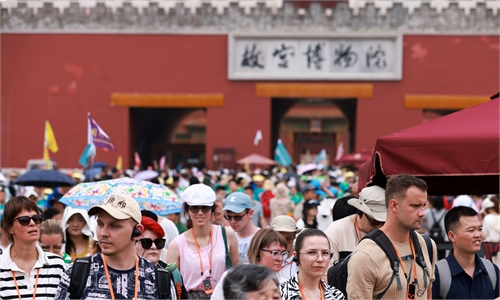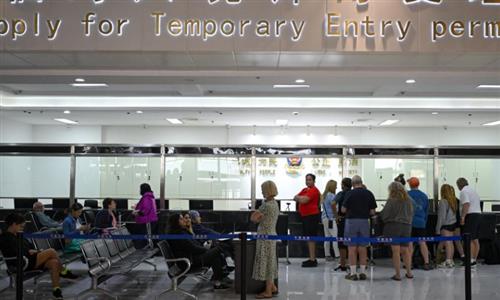China's 144-hour visa-free transit policy extended to 37 entry ports
Inbound tourism, local economies to get boost

Foreign tourists enjoy the scenery on a bamboo raft on Yulong River in Yangshuo county, Southwest China's Guangxi Zhuang Autonomous Region, on July 15, 2023. Photo: VCG
China added another three entry ports to its 144-hour visa-free transit policy on Monday, expanding the policy coverage to 37 ports in total, which will help boost local inbound tourism where the ports are located and promote local economic development through the lifting of services industries and consumption.
The expansion also marks China's ramped-up efforts to improve opening-up in the services sector, analysts said.
The National Immigration Administration (NIA) announced that China's 144-hour visa-free transit policy will be extended to three more entry ports, taking the number of ports covered by the policy to 37.
The three new ports are Zhengzhou Xinzheng International Airport in Central China's Henan Province, Lijiang Sanyi International Airport and the Mohan railway port in in Southwest China's Yunnan Province, the NIA said in a statement.
Starting from Monday, the 144-hour visa-free transit policy at the Zhengzhou airport allowed visitors to travel within the administrative region of Henan. Additionally, the specific area covered by the 144-hour visa-free policy in Yunnan Province will be expanded from the previous Kunming to include eight other cities and regions, such as Lijiang, Dali and Xishuangbanna.
The Mohan railway port will greatly facilitate the entry of foreign tourists entering China through the China-Laos Railway, as Mohan is an important station of the railway at China's border with Laos, Yang Yong, a professor and deputy director of the School of Economics and Management at East China Normal University, told the Global Times on Monday.
"The main sources of Chinese inbound tourism are still concentrated in East and Southeast Asian countries. Therefore, the two newly added transit ports in Yunnan can greatly facilitate the entry of Southeast Asian tourists and enhance the development of Yunnan's tourism," Yang said.
The effect of the visa-free policy has already begun to show results. Driven by policy and market factors, inbound tourism in Kunming ushered in a fast lane of development.
In the first half of the year, foreigners coming to China through Kunming Changshui International Airport, which is a 144-hour visa-free transit port opened in January 2019, continued to increase, with people entering for travel accounting for 77.62 percent. Among this group, the number of foreigners from Malaysia, Thailand, Singapore, Laos and Vietnam ranked in the top five, according to official data.
According to statistics from the NIA, in the first half of 2024, a total of 14.635 million foreign nationals visited China, up 152.7 percent year-on-year. Among them, 8.542 million foreigners entered China through visa-free policies, accounting for 52 percent, an increase of 190.1 percent year-on-year.
"As China continues to open up to the outside world, it is not only necessary to increase economic cooperation but also to increase cultural exchanges. Tourism is an important way to promote people-to-people exchanges," said Yang.
In the past, domestic tourism and outbound tourism developed at a fast pace and became the major growth engine of the tourism sector in China. However, with the introduction of more and more inbound tourism facilitation policies, it is believed that inbound tourism will also develop in an increasingly better way, Yang noted.
"Especially for tourists from Europe and the US, who had little understanding of China before, visa facilitation can greatly promote their travel interest in China," Yang said.
Foreign citizens from 54 countries including the US, Canada, the UK, Austria, Belgium, the United Arab Emirates and Qatar who enter China through the designated entry ports and hold valid international travel documents and connecting tickets to a third country or region within 72/144 hours, will be allowed to stay in designated areas for tourism, business, and visiting relatives visa-free, according to the NIA.
The visa-free policy has played an important role in promoting inbound tourism, Jiang Yiyi, a vice president of the School of Leisure Sports and Tourism at Beijing Sport University, told the Global Times on Monday.
The visa-free policies launched in January 2013 have played a crucial role in supporting China's high-level opening-up and facilitating international travel and exchanges, the NIA said in a statement.
"In recent years, China has accelerated the supply-side reform of tourism, having promoted the in-depth integration of culture and tourism, and created a wealth of high-quality tourism products. Cultural tourism experiences, such as watching Chinese dramas, wearing hanfu and visiting museums, allow inbound tourists to have a deep understanding of Chinese culture and experience local characteristics." Jiang said.

Foreigners pose for a group photo with traditional Chinese lacquer fans made by themselves in Haikou, south China's Hainan Province, July 6, 2024. Photo: Xinhua
China's overall reception capacity and public service level of inbound tourism have been continuously improved, and the shortcomings such as payment facilities have been further solved, providing foreign tourists with international-level travel services, Jiang noted.


